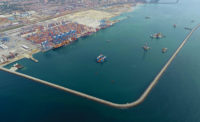Bouygues and FDOT also debated whether to tie or weld the rebar cages. "We typically weld the reinforcing steel to get very tight tolerances," says Brais. "In the contract, FDOT said no welding—tie them. We tried to convince them, but ultimately we tied them. We've gotten very good results."
In placing the 13-ton concrete panels, Bouygues has to account for the varying patterns within each tunnel ring. Each ring has five standard segments, one key segment and two counterkeys. "Our software is constantly predicting how the ring should be aligned," says Scott. A vacuum-equipped segment erector picks up each panel and rotates it into place. In all, it takes about one hour to erect one ring. Scott says the contractor is averaging about eight rings a day.
It took two months of preparation to turn Harriet after she finished east-bound excavation. Crews scrambled to complete a 32-ft-dia, 5-ft-high, 120-ton Teflon disc to carry the 2,000-ton shield, which was detached from its 361 ft of trailing gear, on its 9-day, 180° spin. Then, crews reattached her gear for west-bound excavation, which took another two months, according to Falco.
In the meantime, CSM is being used to pre-treat three of five cross passages. The other two could not receive CSM panel reinforcements due to their locations in the water. For those two, Bouygues is using artificial ground freezing. The risk is that, "after freezing, when it thaws out, collapse is possible," says Brais. "Then, you would have concentrated, irregular loads on the tunnel lining. So, the object is to freeze a ring around the perimeter, not a solid block. We create a six-foot-thick ring and mine inside it."
For each passage, 44 pipes are installed to inject the earth with freezing brine. Steel support frames protect the two main tunnels' segmental lining from potential deformation due to the pressure of the frozen ground in the cross-passage area. It takes about a month to freeze the ground enough to begin mining the cross passage. After about two months of excavation, the ground will be thawed out over several weeks.
A temporary lining of steel arch ribs and shotcrete supports the passage during construction, then is replaced by permanent cast-in-place concrete. A steel door is installed so that, if something goes wrong, workers can seal off the cross passage and keep water from entering the main tunnels.
Mechanical-electrical work began in March. Brais expects to add another 150 workers on-site in June for more than 600 total. Tunnel tests begin in December. So far, all has gone well. For example, the team boasts good community relations and no major injuries through almost three million man-hours.
"Right now, what wakes me up in the morning is the schedule," Brais says. After Harriet's work is done, "there's a lot left to do."
This story was updated April 3 to reflect the correct base city of Malcolm Drilling.







Post a comment to this article
Report Abusive Comment